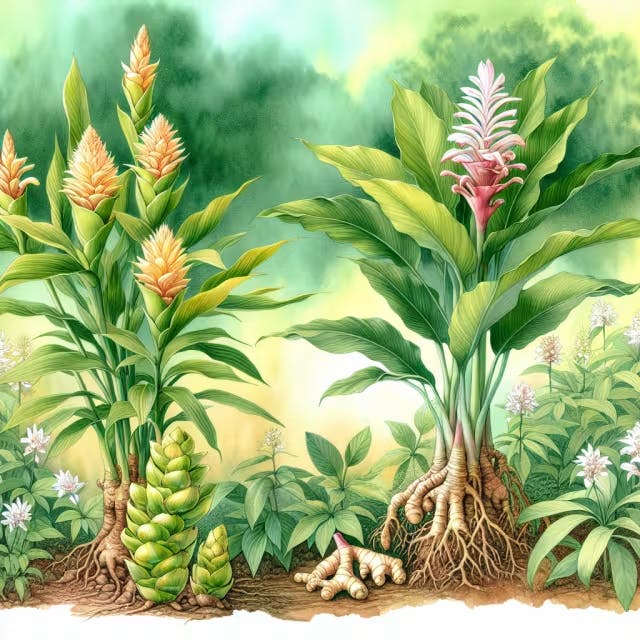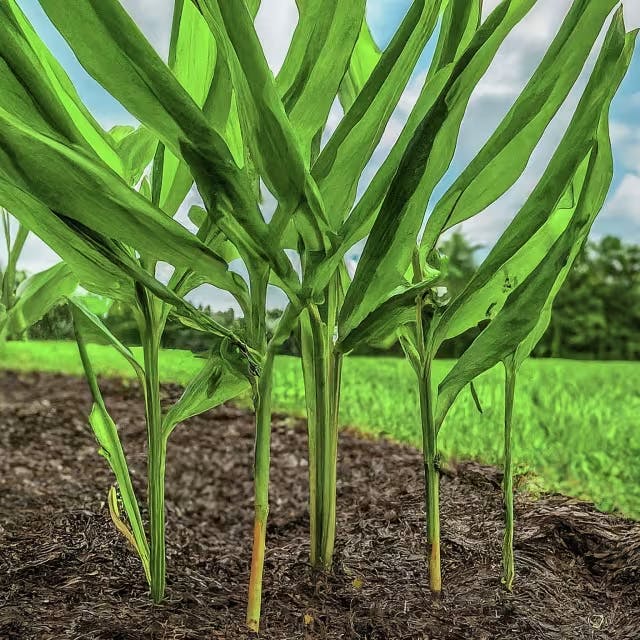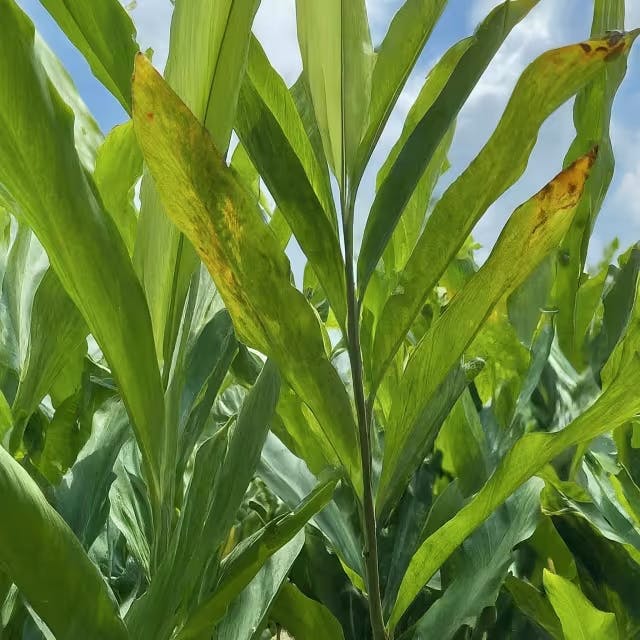Growing Ginger and Galangal: A Tale of Triumph
Go4Turf
February 12, 2024

Diving into the world of gardening, especially with unique spices like ginger and galangal, can be as enriching as savoring the sweet corn of Indiana summers—a season brimming with life and flavor. Just as the Indiana State Fair celebrates the climax of harvest with its showcase of agriculture, growing ginger and galangal triumphantly celebrates the blending of careful gardening with the culinary majesty these roots contribute to dishes worldwide. This tale of triumph is not just about planting; it's about nurturing the earth and reaping the bounty through a journey of discovery, patience, and ultimately, success in growing these aromatic treasures.
Key Takeaways
Gardening with ginger and galangal enriches the culinary and gardening experience, akin to celebrating a bountiful harvest like that of Indiana's sweet corn season.
Success in growing these aromatic plants is a journey of discovery, patience, and nurturing the earth.
Understanding the basics of growing ginger and galangal is crucial for a successful gardening experience.
The best soil and conditions are essential for the health and growth of ginger and galangal plants.
A step-by-step guide can help navigate the planting process, ensuring the plants receive the care they need from the start.
Troubleshooting common problems is key to maintaining healthy plants and achieving a bountiful harvest.

Understanding the Basics of Growing Ginger and Galangal
Growing ginger and galangal holds promise for both novice and experienced gardeners. These aromatic rhizomes thrive under specific conditions which, when met, lead to a rewarding harvest. For a successful journey in growing these plants, focus on selecting the right variety, providing optimal soil conditions, and ensuring proper care.
Select the Right Variety: Choose healthy, plump rhizomes from a reputable source to ensure a strong start. Freshness is key, as older specimens may struggle to sprout.
Soil and Planting: Both ginger and galangal prefer well-draining soil rich in organic matter. Aim for a pH between 5.5 and 6.5. Plant the rhizomes just below the soil surface, with the eye buds facing upward.
Water and Temperature: Maintain consistent moisture without overwatering to prevent rot. These tropical plants enjoy warmth, thriving in temperatures between 70°F and 90°F.
Location: While they enjoy warmth, direct sunlight can be too intense. Opt for a spot that offers partial shade or filtered sunlight.
Harvest: Patience is key. Ginger usually requires 8-10 months, while galangal might need a year to mature. Harvest when the leaves start to yellow and die back.
For comprehensive insights on ensuring plant health and growth, explore essential gardening tips. Additionally, understanding how to propagate other similar plants, like lemongrass, can supplement your gardening skills, found in this guide on propagating lemongrass successfully.
For more detailed information and regional guidance on growing these aromatic plants, the University of Illinois Extension and the University of Wisconsin Division of Extension are valuable resources. They provide academic expertise and community support tailored to maximizing the growth and health of ginger and galangal in diverse conditions.

The Best Soil and Conditions for Your Ginger and Galangal Plants
For thriving ginger and galangal plants, selecting the right soil and environmental conditions is crucial. These tropical herbs flourish in well-draining, loamy soil enriched with organic matter. A pH level between 5.5 and 6.5 creates the perfect balance for nutrient absorption.
Location: Choose a warm, sheltered spot with partial sunlight. While they can tolerate full sun, protection during the hottest parts of the day prevents leaf burn.
Watering: Keep the soil consistently moist but not waterlogged. Overwatering can lead to root rot, a common issue with ginger and galangal.
Implementing these steps contributes significantly to transforming your gardening skills and increasing your herbs' growth and flavor.
For detailed guidance on growing these herbs in various climates, the University of Wisconsin Division of Extension and Gardener's Path offer comprehensive resources. By investing time in understanding the specific needs of ginger and galangal, gardeners can ensure a bountiful harvest, enhancing their culinary experience with fresh, aromatic roots directly from their garden.

Step-by-Step Guide to Planting Ginger and Galangal
To embark on the journey of growing ginger and galangal, the key ingredient is choosing the right rhizomes. Firm, plump rhizomes with visible eyes (growth buds) promise a successful start. Here's a simplified approach to plant these culinary treasures:
Selecting Rhizomes: Opt for healthy, plump ones. Local garden centers or specialty stores often provide the best options.
Pre-planting Prep: Cut larger rhizomes into pieces, each with at least one growth bud. Before planting, let these pieces dry for a day or two to prevent rot.
Planting Time: Late winter or early spring is ideal. However, in tropical climates, planting can be done year-round.
For those new to gardening or seeking to improve their skills, incorporating essential tips to ensure plant health and growth is crucial. Understanding sunlight, water, nutrients, and more can elevate the gardening experience and success significantly. For further insights, consider exploring tips on transforming your black thumb into a green thumb.
Soil and Location: Both ginger and galangal thrive in rich, well-draining soil. A mix of garden soil and compost works well. Choose a spot with partial shade to protect them from the harshest sun rays.
Planting Depth and Spacing: Plant the rhizomes 1-2 inches deep, with the growth buds facing upward. Space them about 8 inches apart to give enough room for growth.
Watering and Care: Keep the soil consistently moist but not waterlogged. Mulching helps retain soil moisture and suppress weeds. As the plants grow, organic fertilizer can be added to encourage lush growth.
Harvesting ginger and galangal is a rewarding experience, usually ready within 8-10 months when the leaves begin to yellow and die back. Carefully dig around the plants to harvest the rhizomes, leaving some in the ground to regrow if desired.
Growing these aromatic rhizomes not only enhances your garden but also your culinary ventures. From adding a zesty flavor to dishes to enjoying their medicinal benefits, the journey of growing ginger and galangal is indeed a tale of triumph.
For additional guidance and gardening information, connecting with local extension services like the University of Wisconsin-Madison Division of Extension offers invaluable resources and support tailored to your region's climatic conditions and soil types.

Troubleshooting Common Problems in Growing Ginger and Galangal
When venturing into growing ginger and galangal, enthusiasts often encounter a couple of snags that can hinder the journey to a triumphant harvest. Understanding these common issues and learning how to tackle them effectively can significantly improve your gardening experience.
Pests and Diseases
Rhizome Rot: This condition is often caused by overwatering or poor drainage. Ensure your planting site or pots have well-draining soil to combat this issue.
Leaf Spot: Fungal diseases can cause unsightly spots on leaves. Improve air circulation and avoid wetting the foliage when watering to prevent this.
Cultural Issues
Poor Germination: Sometimes, seeds or rhizomes may fail to sprout. This could be due to old planting material. Always use fresh, healthy rhizomes for best results.
Weak Growth: Insufficient light or nutrients can stunt your plants. Position them in a spot that receives ample sunlight and consider enriching the soil with essential gardening tips to ensure plant health and growth.
Table of Troubleshooting Solutions
Problem | Possible Cause | Solution |
Rhizome Rot | Overwatering, Poor Drainage | Ensure well-draining soil, water appropriately |
Leaf Spot | Fungus, Excess Moisture | Improve air circulation, avoid wetting leaves |
Poor Germination | Old Rhizomes | Use fresh, healthy rhizomes |
Weak Growth | Low Light/Nutrients | Provide more sunlight, fertilize the soil |
By addressing these common challenges, growing ginger and galangal becomes less of a daunting task and more of a rewarding journey. Remember, even seasoned gardeners encounter setbacks, but with the right knowledge and tools at your disposal, you're well on your way to nurturing thriving plants. For more tips on ensuring your gardening success, explore our educational resources here. In conclusion, growing ginger and galangal can indeed be a tale of triumph when armed with the right knowledge and dedication. By selecting healthy rhizomes, providing the ideal soil and conditions, and vigilantly caring for your plants, you can navigate common challenges and achieve a bountiful harvest. Embracing the journey with patience and persistence will not only yield aromatic and flavorful rewards but also enrich your gardening experience.
Frequently Asked Questions
What are the best conditions for growing ginger and galangal?
For successful ginger and galangal growth, consider these critical factors:
Select the Right Variety: Obtain fresh, plump rhizomes with visible growth buds from reputable sources.
Soil Quality: Use well-draining, loamy soil rich in organic matter, aiming for a pH of 5.5 to 6.5.
Environmental Conditions: Choose a warm, sheltered area that receives partial sunlight to prevent leaf burn.
Watering: Maintain soil moisture without causing waterlog to avoid root rot.
Planting should be done just below the soil surface, with the buds facing up, in a location that avoids the harshest midday sun. These conditions, combined with regular care and patience, will encourage robust growth leading to a rewarding harvest.
How do you select the right variety of ginger and galangal for planting?
To select the right variety of ginger and galangal for planting:
Opt for healthy, plump rhizomes with visible eye buds (growth buds) for a stronger start. Source them from reputable local garden centers or specialty stores to ensure quality.
Pre-planting preparation involves cutting larger rhizomes into pieces, each with at least one growth bud. Let these pieces dry for a day or two before planting to help prevent rot.
Consider the climatic suitability of the variety. While most ginger and galangal varieties prefer tropical conditions, some can tolerate less warmth, making them suitable for cooler climates.
Remember, selecting the right variety is just the beginning. Providing the plants with well-draining soil rich in organic matter, adequate warmth, and consistent moisture without overwatering is crucial for success.
What are the steps for planting and care of ginger and galangal?
To successfully plant and care for ginger and galangal, follow these steps:
Selecting Rhizomes: Choose firm, plump rhizomes with visible eyes (growth buds), preferably from local garden centers or specialty stores.
Pre-planting Preparation: Cut larger rhizomes into pieces, each with at least one growth bud, and let them dry for a day or two to prevent rot.
Ideal Planting Time: Late winter or early spring is optimal; in tropical climates, planting can be done year-round.
Soil and Location: Plant in rich, well-draining soil mixed with compost, in a spot with partial shade to protect from direct sunlight.
Planting Depth and Spacing: Plant rhizomes 1-2 inches deep, growth buds facing up, spaced about 8 inches apart.
Watering and Care: Maintain consistently moist soil without overwatering. Mulching helps retain moisture and suppress weeds. Organic fertilizer can encourage growth.
Harvesting: Ginger and galangal are usually ready to harvest in 8-10 months when leaves yellow and die back.
By following these guidelines, you can enjoy the rewarding experience of cultivating these aromatic rhizomes in your garden.
When is the ideal time to harvest ginger and galangal, and how do you know they're ready?
The ideal time to harvest ginger is approximately 8-10 months after planting, while galangal may require up to a year to mature fully. You'll know they're ready for harvest when the leaves start to yellow and die back, indicating the rhizomes have developed sufficiently underground. Prior to this stage, it's essential to ensure the plants have been cared for properly by maintaining well-draining, loamy soil enriched with organic matter, keeping the soil consistently moist but not waterlogged, and providing a location with partial sunlight to protect them from the harshest rays. Monitoring for common issues like rhizome rot and leaf spot by improving air circulation and ensuring proper watering techniques can also significantly impact the health and yield of your ginger and galangal plants.
How can you prevent common pests and diseases affecting ginger and galangal plants?
To prevent common pests and diseases affecting ginger and galangal plants, adopting a few proactive strategies is essential:
Ensure Good Drainage: Plant in well-draining soil to avoid rhizome rot, often caused by overwatering or poor drainage conditions.
Promote Air Circulation: Space plants adequately and opt for a location that allows for good air movement to reduce the risk of fungal diseases like leaf spot. Avoid wetting the foliage directly.
Use Quality Planting Material: Start with fresh, healthy rhizomes to prevent poor germination and ensure vigorous growth. Older rhizomes may not sprout well, leading to weak or no growth.
Manage Light and Nutrients: Provide plants with partial sunlight to prevent weak growth caused by insufficient light. Enrich the soil with organic matter to support strong development.
By focusing on these preventive measures, gardeners can significantly reduce the incidence of pests and diseases, leading to healthier ginger and galangal plants and a more rewarding harvest.
What are the benefits of growing ginger and galangal in your garden?
Growing ginger and galangal in your garden brings several benefits, including enhancing your culinary ventures with fresh, aromatic roots and enjoying their medicinal properties. These tropical herbs flourish in well-draining, loamy soil enriched with organic matter, requiring a pH level between 5.5 and 6.5 for optimal nutrient absorption. Selecting the right location is crucial; a warm, sheltered spot with partial sunlight suits them best, preventing leaf burn while ensuring they receive ample warmth.
Key points include:
Choosing healthy, plump rhizomes with visible growth buds for planting, ideally in late winter or early spring.
Maintaining soil moisture without overwatering to avoid common issues like rhizome rot, ensuring well-draining conditions.
Harvesting ginger and galangal requires patience, usually ready between 8-10 months for ginger and up to a year for galangal, when the leaves begin to yellow and die back.
By carefully managing these factors, gardeners can enjoy a bountiful harvest, enriching both their gardens and kitchen with the unique flavors and health benefits of these versatile herbs.